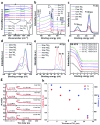Ultrathin-Film Titania Photocatalyst on Nanocavity for CO2 Reduction with Boosted Catalytic Efficiencies
- PMID: 30546916
- PMCID: PMC6282774
- DOI: 10.1002/gch2.201800032
Ultrathin-Film Titania Photocatalyst on Nanocavity for CO2 Reduction with Boosted Catalytic Efficiencies
Abstract
Photocatalytic CO2 reduction with water to hydrocarbons represents a viable and sustainable process toward greenhouse gas reduction and fuel/chemical production. Development of more efficient catalysts is the key to mitigate the limits in photocatalytic processes. Here, a novel ultrathin-film photocatalytic light absorber (UFPLA) with TiO2 films to design efficient photocatalytic CO2 conversion processes is created. The UFPLA structure conquers the intrinsic trade-off between optical absorption and charge carrier extraction efficiency, that is, a solar absorber should be thick enough to absorb majority of the light allowable by its bandgap but thin enough to allow charge carrier extraction for reactions. The as-obtained structures significantly improve TiO2 photocatalytic activity and selectivity to oxygenated hydrocarbons than the benchmark photocatalyst (Aeroxide P25). Remarkably, UFPLAs with 2-nm-thick TiO2 films result in hydrocarbon formation rates of 0.967 mmol g-1 h-1, corresponding to 1145 times higher activity than Aeroxide P25. This observation is confirmed by femtosecond transient absorption spectroscopic experiments where longer charge carrier lifetimes are recorded for the thinner films. The current work demonstrates a powerful strategy to control light absorption and catalysis in CO2 conversion and, therefore, creates new and transformative ways of converting solar energy and greenhouse gas to alcohol fuels/chemicals.
Keywords: CO2 photoreduction; light absorption; nanocavity; photocatalysis; ultrathin‐film titania.
Conflict of interest statement
The authors declare no conflict of interest.
Figures




Similar articles
-
Decomposition of dimethyl methylphosphonate vapor on ultrathin-film titania photocatalytic light absorber.Chemosphere. 2021 Jul;274:129719. doi: 10.1016/j.chemosphere.2021.129719. Epub 2021 Jan 23. Chemosphere. 2021. PMID: 33540318
-
Highly efficient visible light photocatalytic reduction of CO2 to hydrocarbon fuels by Cu-nanoparticle decorated graphene oxide.Nano Lett. 2014 Nov 12;14(11):6097-103. doi: 10.1021/nl503609v. Epub 2014 Nov 3. Nano Lett. 2014. PMID: 25354234
-
Insights on Carbon Neutrality by Photocatalytic Conversion of Small Molecules into Value-Added Chemicals or Fuels.Acc Mater Res. 2022 Dec 23;3(12):1206-1219. doi: 10.1021/accountsmr.2c00095. Epub 2022 Nov 4. Acc Mater Res. 2022. PMID: 36583010 Free PMC article.
-
Cocatalysts in Semiconductor-based Photocatalytic CO2 Reduction: Achievements, Challenges, and Opportunities.Adv Mater. 2018 Feb;30(7). doi: 10.1002/adma.201704649. Epub 2018 Jan 8. Adv Mater. 2018. PMID: 29315885 Review.
-
Advanced nanomaterials for highly efficient CO2 photoreduction and photocatalytic hydrogen evolution.Sci Technol Adv Mater. 2022 Dec 8;23(1):866-894. doi: 10.1080/14686996.2022.2149036. eCollection 2022. Sci Technol Adv Mater. 2022. PMID: 36506822 Free PMC article. Review.
References
-
- Chang X. X., Wang T., Gong J. L., Energy Environ. Sci. 2016, 9, 2177.
-
- White J. L., Baruch M. F., Pander J. E., Hu Y., Fortmeyer I. C., Park J. E., Zhang T., Liao K., Gu J., Yan Y., Shaw T. W., Abelev E., Bocarsly A. B., Chem. Rev. 2015, 115, 12888. - PubMed
-
- Zheng Y., Zhang W. Q., Li Y. F., Chen J., Yu B., Wang J. C., Zhang L., Zhang J. J., Nano Energy 2017, 40, 512.
-
- Inoue T., Fujishima A., Konishi S., Honda K., Nature 1979, 277, 637.
-
- Lan Y. C., Lu Y. L., Ren Z. F., Nano Energy 2013, 2, 1031.
LinkOut - more resources
Full Text Sources

